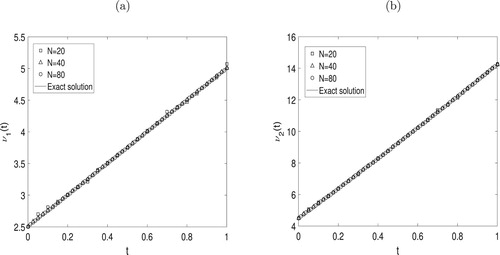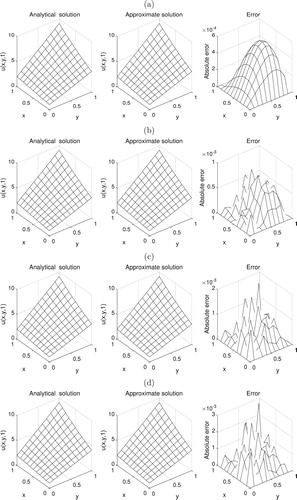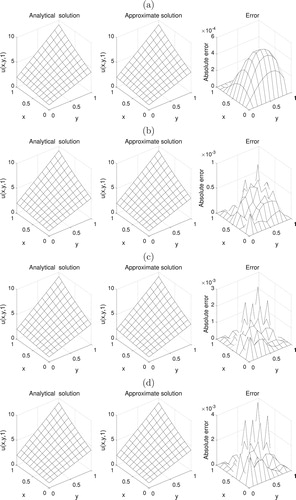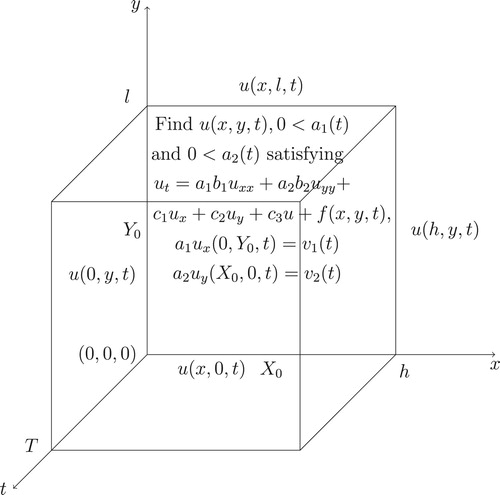Figures & data
Figure 2. The exact (Equation29(29)
(29) ) and numerical solutions for (a)
and (b)
, with
and with various numbers of time steps
, for direct problem.

Table 1. The rmse values ((Equation32 (32)
(32)  (32) ) and (Equation33
(32) ) and (Equation33 (33)
(33)  (33) )) for
(33) )) for 
 and
and 
 , with
, with 
 and with various
and with various 
 , for direct problem.
, for direct problem.
Figure 3. The objective function (Equation19(19)
(19) ), as a function of the number of iterations, for Example 1 with
noise.
![Figure 3. The objective function (Equation19(19) F(a1,a2)=∑n=1N[a1nux(0,Y0,tn)−ν1(tn)]2+∑n=1N[a2nuy(X0,0,tn)−ν2(tn)]2,(19) ), as a function of the number of iterations, for Example 1 with p∈{0,1%,3%,5%} noise.](/cms/asset/5cae5cf9-a60f-4f18-9376-4cb3dac8c288/gipe_a_1814282_f0003_ob.jpg)
Figure 4. The exact (Equation31(31)
(31) ) and numerical solutions for: (a)
and (b)
, for Example 1 with
noise.
![Figure 4. The exact (Equation31(31) a1(t)=1+t,a2(t)=1+2t,t∈[0,1].(31) ) and numerical solutions for: (a) a1(t) and (b) a2(t), for Example 1 with p∈{0,1%,3%,5%} noise.](/cms/asset/1a9f41ab-7600-4c44-aa74-6ec3a73fb435/gipe_a_1814282_f0004_ob.jpg)
Figure 5. The analytical (Equation30(30)
(30) ) and approximate solutions for the temperature
, for Example 1 with (a) no noise, (b)
noise, (c)
noise, and (d)
noise. The absolute error between them is also included.

Table 2. The number of iterations, the values of the objective function (19) at final iteration, the rmse values ((26) and (27)) and the computational time, for 
 , for Examples 1 and 2.
, for Examples 1 and 2.
Figure 6. The objective function (Equation19(19)
(19) ), as a function of the number of iterations, for Example 2 with
noise.
![Figure 6. The objective function (Equation19(19) F(a1,a2)=∑n=1N[a1nux(0,Y0,tn)−ν1(tn)]2+∑n=1N[a2nuy(X0,0,tn)−ν2(tn)]2,(19) ), as a function of the number of iterations, for Example 2 with p∈{0,1%,3%,5%} noise.](/cms/asset/296b85d8-7779-4fb7-a6b4-ae25021b8f0b/gipe_a_1814282_f0006_ob.jpg)
Figure 7. The exact (Equation35(35)
(35) ) and numerical solutions for: (a)
and (b)
, for Example 2 with
noise.
![Figure 7. The exact (Equation35(35) a1(t)=1+cos2(2πt),a2(t)=1+cos2(3πt),t∈[0,1].(35) ) and numerical solutions for: (a) a1(t) and (b) a2(t), for Example 2 with p∈{0,1%,3%,5%} noise.](/cms/asset/f4330a8a-b678-4ab1-ba68-688209b4eb16/gipe_a_1814282_f0007_ob.jpg)
Figure 8. The analytical (Equation30(30)
(30) ) and approximate solutions for the temperature
, for Example 2 with (a) no noise, (b)
noise, (c)
noise, and (d)
noise. The absolute error between them is also included.


